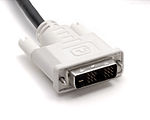
Back واجهة رقمية مرئية Arabic DVI Byelorussian DVI BS DVI Catalan DVI (konektor) Czech Digital Visual Interface Danish Digital Visual Interface German Digital Visual Interface Greek Digital Visual Interface Spanish DVI Estonian
This article needs additional citations for verification. (May 2023) |
 | |||
 A male DVI-D (single link) connector | |||
| Type | Digital computer video connector | ||
|---|---|---|---|
| Production history | |||
| Designer | Digital Display Working Group | ||
| Designed | April 1999 | ||
| Produced | 1999–present | ||
| Superseded | VGA connector | ||
| Superseded by | DisplayPort, HDMI | ||
| General specifications | |||
| Hot pluggable | Yes | ||
| External | Yes | ||
| Video signal |
Digital video stream: Single link: 1920 × 1200 (WUXGA) @ 60 Hz Dual link: 2560 × 1600 (WQXGA) @ 60 Hz Analog video stream: 1920 × 1200 (WUXGA) @ 60 Hz | ||
| Pins |
DVI-D Single Link: 19 DVI-D Dual Link: 25 DVI-I Single Link: 23 DVI-I Dual Link: 29 DVI-A: 11 DVI-M1-DA: 35 | ||
| Data | |||
| Bitrate |
(Single link) 3.96 Gbit/s (Dual link) 7.92 Gbit/s | ||
| Max. devices | 1 | ||
| Protocol | 3 × transition minimized differential signaling data and clock | ||
| Pinout | |||
 | |||
| A female DVI-I socket from the front | |||
 | |||
| Color coded (click to read text) | |||
| Pin 1 | TMDS data 2− | Digital red− (link 1) | |
| Pin 2 | TMDS data 2+ | Digital red+ (link 1) | |
| Pin 3 | TMDS data 2/4 shield | ||
| Pin 4 | TMDS data 4− | Digital green− (link 2) | |
| Pin 5 | TMDS data 4+ | Digital green+ (link 2) | |
| Pin 6 | DDC clock | ||
| Pin 7 | DDC data | ||
| Pin 8 | Analog vertical sync | ||
| Pin 9 | TMDS data 1− | Digital green− (link 1) | |
| Pin 10 | TMDS data 1+ | Digital green+ (link 1) | |
| Pin 11 | TMDS data 1/3 shield | ||
| Pin 12 | TMDS data 3− | Digital blue− (link 2) | |
| Pin 13 | TMDS data 3+ | Digital blue+ (link 2) | |
| Pin 14 | +5 V | Power for monitor when in standby | |
| Pin 15 | Ground | Return for pin 14 and analog sync | |
| Pin 16 | Hot plug detect | ||
| Pin 17 | TMDS data 0− | Digital blue− (link 1) and digital sync | |
| Pin 18 | TMDS data 0+ | Digital blue+ (link 1) and digital sync | |
| Pin 19 | TMDS data 0/5 shield | ||
| Pin 20 | TMDS data 5− | Digital red− (link 2) | |
| Pin 21 | TMDS data 5+ | Digital red+ (link 2) | |
| Pin 22 | TMDS clock shield | ||
| Pin 23 | TMDS clock+ | Digital clock+ (links 1 and 2) | |
| Pin 24 | TMDS clock− | Digital clock− (links 1 and 2) | |
| C1 | Analog red | ||
| C2 | Analog green | ||
| C3 | Analog blue | ||
| C4 | Analog horizontal sync | ||
| C5 | Analog ground | Return for R, G, and B signals | |
Digital Visual Interface (DVI) is a video display interface developed by the Digital Display Working Group (DDWG). The digital interface is used to connect a video source, such as a video display controller, to a display device, such as a computer monitor. It was developed with the intention of creating an industry standard for the transfer of uncompressed digital video content.
DVI devices manufactured as DVI-I have support for analog connections, and are compatible with the analog VGA interface[1] by including VGA pins, while DVI-D devices are digital-only. This compatibility, along with other advantages, led to its widespread acceptance over competing digital display standards Plug and Display (P&D) and Digital Flat Panel (DFP).[2] Although DVI is predominantly associated with computers, it is sometimes used in other consumer electronics such as television sets and DVD players.
- ^ "Digital Visual Interface adoption accelerates as industry prepares for next wave of DVI-compliant products". DDWG, copy preserved by Internet Archive. February 16, 2000. Archived from the original on 28 August 2007. Retrieved 29 March 2012.
{{cite news}}: CS1 maint: bot: original URL status unknown (link) - ^ Eiden, Hermann (July 7, 1999). "TFT Guide Part 3 - Digital Interfaces". TomsHardware.com. Retrieved 29 March 2012.